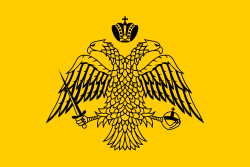This section needs additional citations for verification .(January 2026) |

The Greek Orthodox churches in the diaspora under the Ecumenical Patriarchate use a black double-headed eagle in a yellow field as their flag or emblem.
This section needs additional citations for verification .(January 2026) |

The Greek Orthodox churches in the diaspora under the Ecumenical Patriarchate use a black double-headed eagle in a yellow field as their flag or emblem.
The eagle is depicted as clutching a sword and an orb with a crown above and between its two heads. [1]
| | This section needs expansion. You can help by adding to it. (November 2025) |
It is not surprising that all symbols of Mount Athos, especially the Byzantine double-eagle and the Holy Virgin, who is the patron of the Holy Mount, represent old Byzantine traditions. [...] The flag of Mount Athos (Fig. 1) is golden yellow bearing the black Byzantine double-headed eagle with an imperial crown. The eagle holds on its claws an orb of black with golden bands and a black....